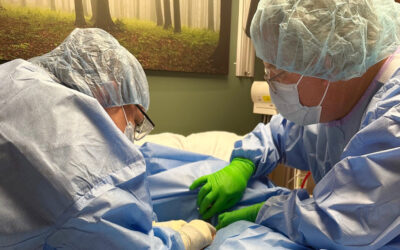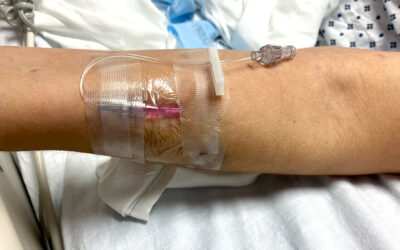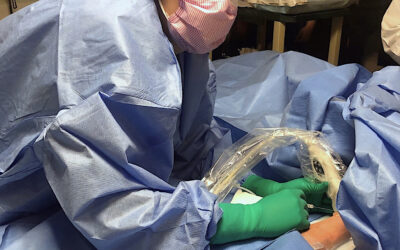Implanted Port Obstructs PICC Insertion illustrates how our Vascular Access Specialist determined that her attempted PICC insertion was obstructed by an implanted port, and the clinician was able to create and implement a solution to meet the vascular access needs of the patient.
Implanted Port Obstructs PICC Insertion
– Clinical Case
This case occurred in a tertiary care facility where a patient with pre-existing vascular access devices needed additional access for multiple infusions and intravenous nutritional support. After a thorough assessment of what was in place and what was needed, the Vascular Wellness vascular access specialist and the medical team agreed that a PICC line would meet the patient’s additional vascular access needs. During the sterile procedure, the clinician made several attempts to insert and position the PICC line to an ideal anatomical location. Realizing the pre-existing port was most likely obstructing the passage of the PICC, the clinician knew the PICC could not be properly placed and stopped the procedure.
Implanted Port Obstructs PICC Insertion
– Diagnosis and Treatment
Having reviewed a chest X-ray prior to the insertion attempt, the Vascular Wellness clinician knew the previously inserted implanted port was in a shallow position in the Superior Vena Cava (SVC). Since Total Parenteral Nutrition (TPN) is highly concentrated and requires a deep SVC location for proper hemodilution, this shallow position would block access to the required deeper SVC location for the PICC. The clinician conferred with their Vascular Wellness Administrator-On-Call for a second opinion and the decision was made to attempt a Small-Bore Internal Jugular catheter on the right side because there was a possibility that placement on the left side could still be blocked by the Port catheter. This course of action was shared with the medical team, and the team agreed that this was an excellent solution.
The placement of a second central line needs careful consideration. As Vascular Access Specialists, we may be consulted to place a second central line, and we can offer suggestions to mitigate this additional risk to the patient. However, there are times when a patient’s condition requires additional access. The implications of a second central line need to be understood from both a patient outcome perspective and an inserting clinician perspective. This training is integral to our practice, and our clients and partners trust us for excellent vascular access clinical decisions and successful line placement, including in difficult and complex cases.
The Vascular Wellness vascular access specialist was able to skillfully place a Small-Bore Internal Jugular catheter on the right side with a tip termination in the deep cavoatrial junction (CAJ), an ideal position considering the patient’s needed therapies. The line was verified, and the patient was able to receive the prescribed therapies at the bedside without delay.
Vascular Access Specialists
– Key Points
We are Vascular Access Specialists because we are highly specialized in the field of vascular access, we can recognize problems that nurses with less experience and training are unable to identify, and we can problem-solve with the patient’s medical team to ensure the needed vascular access is achieved at the bedside without any unnecessary delay. Our clinicians have immediate access to consult with an Administrator-On-Call (an experienced, practicing Vascular Access Specialist who serves as an escalation path, should it be needed), as well as other Vascular Access Specialists in the field. Because of this, and because our clinicians are trained in placement of both standard and advanced lines, the Vascular Wellness clinician was able to respond immediately with a vetted solution.
This case is a great example of how a patient’s relatively basic vascular access needs can quickly become more complicated, causing a “Delay Cascade,” the concept that describes how delays in initial diagnosis and treatment can cause increased length of stay, worsening patient condition, antibiotic resistance, decreased patient satisfaction, and wasting of clinical resources (see References below). An internal or external PICC nurse in this scenario may not have the skills, experience, or team available immediately to help problem solve, or the ability to spend the time to problem solve. This results in treatment delays while the patient waits for another assessment to determine, and then schedule, another vascular access solution.
At Vascular Wellness, we dedicate 100% of our time, effort, and resources to vascular access, including quality, safety, innovation, and education and training. Our clinicians specialize in the placement of virtually all lines (standard and advanced) and are Vascular Access Board Certified (VA-BC), insured, skill-verified, and salaried W2 employees, which means we deliver consistent, reliable, and quality services to the patient’s bedside.
Our focus, dedication, and expertise mean that medical teams often rely on us to consult with them regarding the best vascular access device for the patient’s needs. This holistic, patient-centered approach to vascular access is beneficial to all stakeholders, and it helps ensure placement of the clinically appropriate line, the first time. As a result, our patients have fewer complications and more favorable outcomes, and these patients are more satisfied with the facility where they are receiving care and treatment.
References regarding “Delay Cascade”
- Heart & Lung. Volume 49, Issue3, Page 273-286, May-June 2020
- Journal of Infusion Nursing. 43(4): p222-228, July-August 2020
- Journal of the American College of Emergency Physicians Open. 2020 Dec; 1(6): 1660–1668
Nurse Clinicians in Action is a spotlight series highlighting some of the interesting cases that Vascular Wellness clinicians have encountered and participated in treatment. These cases involve challenging situations or intriguing clinical presentations and may involve more than one Vascular Wellness clinician, as our clinicians have the ability to consult each other while in the field, as well as an on-call Clinical Administrator via a HIPAA (Health Insurance Portability and Accountability) compliant communication app. In addition, our extensive training program and diverse client base, including Level 1 Trauma Centers, Short Term Acute Care Hospitals, Long Term Acute Care Hospitals, and Skilled Nursing Facilities, provide our clinicians with a wide array of clinical experience and why we believe our clinicians, as a group, are the most experienced and best trained and supported vascular access clinicians.
If you require Vascular Access or want to learn more, speak to the team at Vascular Wellness today. For the latest articles and insights, follow us on LinkedIn, Facebook, Twitter, YouTube, and Instagram.
Vascular Wellness provides:
(1) Comprehensive vascular access services to North Carolina, South Carolina, and Virginia; and
(2) Customized vascular access services to Tennessee, Georgia, and West Virginia; and
(3) Support vascular access services to Pennsylvania, Ohio, and Kentucky.
Internal Jugular Patient Cases
Nurse Clinicians in Action stories highlight some of the interesting cases in which Vascular Wellness clinicians have encountered and participated as valuable team members.
Need a Vascular Access Expert?
We have a 98+% success rate with a 0% insertion-related infection rate across all lines, a three-hour average response time, available 7 days a week, 365 days a year.






